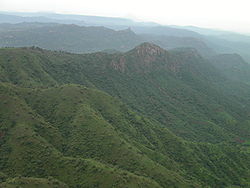| Tigrè region | |
 | |
Location  | |
Coat of arms and flag  | |
| State | Ethiopia |
|---|---|
| Capital | Macallè |
| Surface | 50,286 km² |
| Inhabitants | 4.334.996 (2006) |
| Institutional website | |
Tigrè region is a region (kilil) in the north ofEthiopia on the border withEritrea.
To know
Geographical notes
It borders the Region of the Amara to the south, the Afar region to the east, col Sudan to the west and theEritrea North.
Background
In 1895 following the Italian penetration into Tigrè from the nearby colony of Eritrea the first war broke out between Ethiopia is Italy.
In 1935, at the outbreak of the war that led Vittorio Emanuele III to assume the title of Emperor of Ethiopia, Tigrè was one of the first territories conquered by the Italians: among the first measures, the abolition of slavery and the consequent immediate liberation of all the slaves (October 14, 1935).
In 1998, a war broke out between Eritrea and Ethiopia, centered on a portion of territory that belonged to the Tigrè region and included the village of Badammè. After a 2002 UN resolution, many of these lands were assigned to Eritrea.
Spoken languages
The language used in workplaces and public documents is Tigrinya.
Culture and traditions
Almost the entire population of this region is of Orthodox Christian religion.
Territories and tourist destinations
Urban centers
- Macallè (or Mek'elē) - Capital of the region.
- Have Addi
- Adigrat - Capital at about 2400 m of altitude of the province of Agamé. Known to Italians for the Abyssinian War.
- Adua - Mountain city mainly known to the Italians for the battle of the same name in 1896.
- Axum (or Aksum) - Ancient center of the kingdom of Axum. Today world heritage sites ofUNESCO for its archaeological ruins.
- Hager Selam
- Hawzen - Support base for exploring the numerous rock churches of the north-east of Tigrè.
- Inda Selassie (or Shire)
- Ugorò (Wukro) - City located on the road from Asmara leads to Addis Ababa.
How to get

By plane
Tigrè has an international airport and four commercial airports.
- 1 Macalle airport (o Alula Aba Nega airport; IATA: MQX) (10 km southeast of Macallè). International airport.
- 2 Shire Airport (o Indaselassie airport; IATA: SHC). Commercial airport.
- 3 Humera airport (IATA: HUE). Commercial airport.
- 4 Dansha Airport. Commercial airport.
- 5 Axum airport (IATA: AXU). Commercial airport.
By car
An important land transport artery cuts the Tigrè from north to south. This is facilitated by the highway 2 which runs from Adigrat to Addis Ababa and highway 3 which runs from Inda Selassie in Addis Ababa.
How to get around
What see
- Rock-hewn churches - Similar in their construction to those of Lalibela, they are a distinctive feature of Tigrè. They can be found in Gheralta, Takatisfi, Atsbi and Tembien. The ancient Tigrinya monastery of Debra Damo is only accessible by climbing a 25 meter long rope on the vertical wall of a bare rock peak.
- Rock churches of Tigrè - It is important to bear in mind that two full days are required to visit at least the most beautiful ones. You can start with those of the Takatisfi group, starting with Adigrat. The first is that of "Petro and Paulus", built on top of a cliff and can be reached via a steep staircase made with sticks. Inside there are precious paintings, entrance 50 birr. Then on foot, through cultivated fields, you reach the church of Mikael Mahelizengi with the vault and walls completely carved into the rock, here the entrance is 50 birr, then with a slightly longer walk of about 40 min you will arrive at the church of Medhame Alhem Kesko, entrance 100 birr, certainly the most beautiful , without paintings but with extraordinary bas-reliefs and an original door opening system. In the afternoon let us take you to the Kirkos church, admission of 100 birr, is the least impressive but easily accessible from the road. Stop and sleep in the dusty village of Hawzen where you will find at least two good hotels. Hawzen is logistically perfect to reach the rock churches of the Gheralta group the next day, such as Maryam Korkor is Abuna Yemata Guh, in fact they are only a few km away. The church of Abuna Yemata Guh, must be reached in an inaccessible place that, together with few others in the world, transmits a strong spiritual energy with its spectacular landscape, which almost obliges you to contemplate. It starts at 8:00 and reaches the top at 10:00, the ascent is very steep and for a while you have to climb a rock wall of a few meters, do not worry because the guide you will have with you will know you indicate the right holds, takes 150 birr plus 50 birr for the armed scout. At the top you have to remove your shoes, proceed barefoot along a narrow path with the cliff underneath and enter the church, extraordinary images will appear at your sight: the frescoes with the nine saints who evangelized Ethiopia, the apostles, Abraham, Isaac and Jacob, all perfectly preserved thanks to the very dry air. Back in the valley, if you are still not tired enough, reach Maryam Korkor, then along the road stop at the church of Dugem Selassié, finally to Abram Atshabea, also on the road and very beautiful, of an ocher color, here the entrance is 100 birr. From here, head up to Macallè to spend the night and rest after a very busy day.
What to do
At the table
Safety
Other projects
 Wikipedia contains an entry concerning Tigrè region
Wikipedia contains an entry concerning Tigrè region Commons contains images or other files on Tigrè region
Commons contains images or other files on Tigrè region
